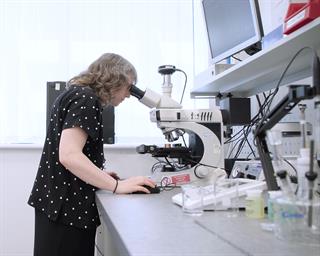Employee perspectives - Dr Sarah Glanvill
I'm an engineer and scientist that helps turn research into real-world innovation.

Good materials science and engineering often goes unnoticed, but bad materials science and engineering is noticed forever. That's why it's so important that materials research and innovation is applied in industry, so that we can design products and processes that perform well throughout their entire lifespan.
Here, Dr Sarah Glanvill, Lead Materials Scientist at Renishaw, shares experiences from her work in materials analysis and research.
During my PhD in corrosion science, I had a lightbulb moment at a conference. After talking to aerospace industry attendees, it became clear that, while my work was incredibly interesting, there was not an obvious route for how my new corrosion understanding could easily transition into a commercial environment. After my PhD I looked at industry roles in materials science and engineering to establish a career where I could quickly translate my knowledge and skills into real-world impact.
The value of materials science and engineering to industry

Materials science is fundamental to good engineering, and this field depends on research both in academia and industry. Knowing how a material works, how to manipulate it and where its properties can be best utilised, relies on principles from both science and engineering. For example, using the techniques for materials characterisation in materials science, like Raman spectroscopy, scanning electron microscopy, mechanical testing and computed tomography, to understand the chemical and structural composition of a material.
This information can tell a material's story and explain how its character impacts its properties. Understanding a material gives us insight into how it can be used and manipulated to make sure each application, product or process is the best it could be, as well as how it can be manufactured productively and without bottlenecks. For example, in the design of a new position encoder, the materials team would be involved in looking at what each component is made of, how they are made, and the potential production roadblocks. We can also assist in looking at opportunities to innovate and invent.
I'm now in a leadership position, working with a group of materials scientists and engineers, all with different specialisms. The team manages projects across the business, from designing and developing new materials technology for specially designed surfaces, to investigating whether we can make products more sustainably without impacting product quality or manufacturing efficiency.
Sustainability and sustainable design
The work that materials scientists and engineers do, and the products they create, can have an infinite impact. Choosing to coat a material, or for example anodising it, can drastically alter its environmental impact, from changing how it is made, to how long it can be used, to how it can be disposed, and to whether it can be recycled. Each material and process must serve a purpose, and the materials research team is constantly thinking, “How could this be made better or differently? How can we meet manufacturing and service demands while ensuring minimal environmental impact?”
Renishaw has committed to a Net Zero target of 2050 at the latest, and materials science and engineering has an important role to play here. It's vital that as we make these changes, we understand the impact on the product's performance and our ability to manufacture it. For example, establishing whether we can swap out easily replaceable materials for ones that reduce carbon emissions, or redesign a product to remove the need for non-recyclable adhesives. We might achieve the latter by using additive manufacturing to consolidate parts or use innovative bonding methods.
Being sustainable means assessing where materials originate, what we do with our waste, as well as our products. This could be finding a use for injection moulding offcuts as recycled plastics, or keeping our waste streams separate and clean for steels and aluminium to aid recycling.
Materials characterisation has a huge role to play in understanding how we can better use our waste. Materials scientists and engineers can explore at the metallographic and molecular level the performance of a material, and how changes in its processing could impact its properties. We provide certainty that making our products more sustainably won't negatively impact their performance.
Turning research into reality
Renishaw invests heavily in research and development, between 12 to 18 per cent annually, with much of this being product development. This is important; as a manufacturer we need to be a step ahead of what our customers want — understanding and predicting their needs and figuring out a way of addressing them before anyone else. We've recognised that to stay one step ahead, our team of materials scientists will sometimes need to work with external experts, we don't know everything!
Part of my role involves working with universities to collaborate on research that could be transferred into industry-ready projects. This involves me assessing the potential impact of the research, how feasible it is, what the gaps are, whether it could become an industrial sized process, and what the limitations are. This means I can act as a bridge, connecting highly specialised research from academia and working alongside academics to apply it to Renishaw projects.
In many senses, my career has come full circle. Working at Renishaw has enabled me to bring my passion for sustainability, and my desire to impact products in the real world, to fruition.
Biography
- Awarded a PhD from the University of Birmingham in Materials Science and Engineering (Corrosion Science)
- Awarded a BSc in Materials Science and Sport Science from the University of Birmingham
- Joined Renishaw in 2018 as a Materials Scientist
- Currently leads a materials research team, working across the business